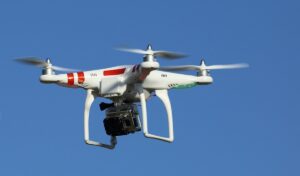I got a drone for Christmas. The first thing my wife asked me was, “Why do you need a drone?” I did not have a great answer, other than to say it would be fun to take aerial videos. My sister teased me, as did my kids, nieces and nephew (Sam Sutherland). They said I was obsessed; they said I was acting like a little kid. My neighbors were worried – “no more nude sunbathing” was awkwardly expressed by more than one.
The new recreational drones represent pretty cool technology. Just a few years ago, the technology was not available to stabilize and control the flying of drones…at least not at an affordable cost. Now, GPS satellites and gyro sensors can do just that. Until recently, the range on remote controlled drones was relatively limited. Now, wireless communication allows for first-person viewing and long-distance control at long-range (up to 500 meters from my Phantom DJI FC40 drone). And until recently, the cameras attached to drones were not of sufficient quality to record high-definition images. Now, simple microchips installed in HD cameras with stabilizing functions allow for professional-grade photography (e.g., GoPro).
And with these drones, there is a new perspective on old things. As one expert described: “People underestimate the human desire to explore – and to see the world in a way they’ve never seen it before.” One of my favorite drone videos is of a fireworks show in Florida. A friend, Zak Kohane, shot a drone video over Harvard Medical School (here). TravelByDrone.com offers a collection of high quality videos from across the world, including amazing shots of an active volcano, migrating gray whales and Chernobyl. MIT uses drones to show people around its complex campus. For me, I took drone videos on our most recent family vacation to Arizona (here and here; disclaimer: for non-family members, home videos shot by drones are not much more exciting than those shot by old-fashion camcorders!).
It is not hard to imagine what will happen with drones over the next few years (here, here and here). Amazon is developing drones to deliver packages. Facebook is developing a drone the size of a 747 that could fly for months at a time, beaming down wireless signals. Drone are being used to capture data impossible for the human eye to see – like gas leaking from a pipeline and food crops suffering from lack of nitrogen.
While it might be a stretch, I cannot help but draw parallels between drones and drug discovery: new technologies, new perspectives, and an exciting future.
Increasingly, we have new technology to assess “causal human biology” for nearly every gene in the human genome, and therefore for nearly every protein-coding drug target. As I have discussed in this blog before, human genetics represents one very powerful form of causal human biology, but there are other ways, too.
With causal human biology comes a new perspective on drug discovery: the path from target identification to clinical validation is no longer the same. In particular, the role of pre-clinical models will be different. In the past, non-human pre-clinical models have been used to select targets, evaluate efficacy, and pick clinical indications; going forward, pre-clinical models – which will always be important – will be used to refine therapeutic hypotheses derived from the ideal model organism, humans.
The hope is that if we pick better drug targets and prosecute these targets with a new perspective, then the future is bright for drug discovery. If we pick targets based on causal human biology, then the success rate of drug discovery will increase. If the success rate goes up, the cost of delivering novel therapies with unambiguous promotable advantage will go down. And if the cost goes down, then health care costs for consumers will also go down.
And one final correlation: both drones and drug discovery are pretty cool. If you haven’t tried them, you should!
Happy New Year!


